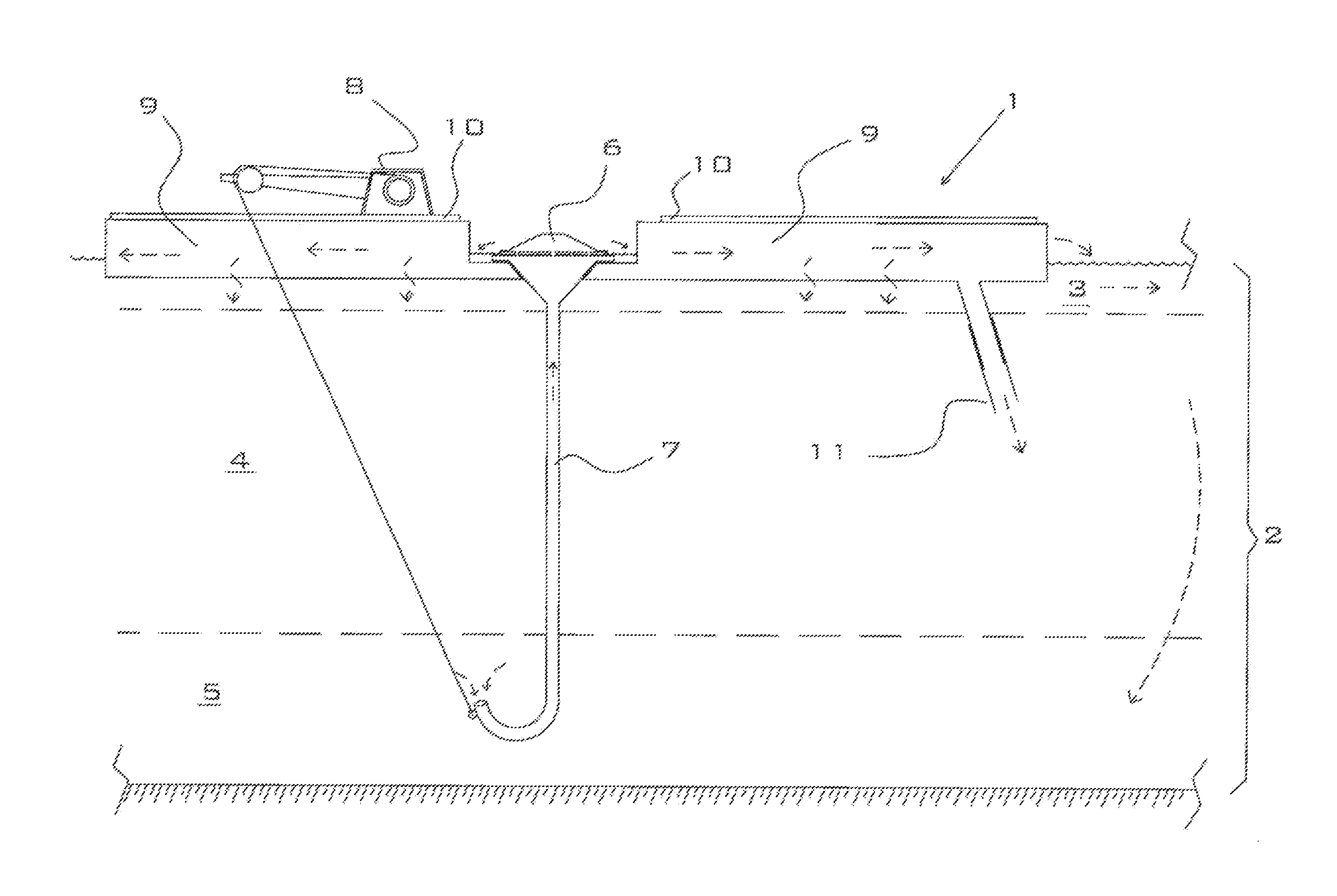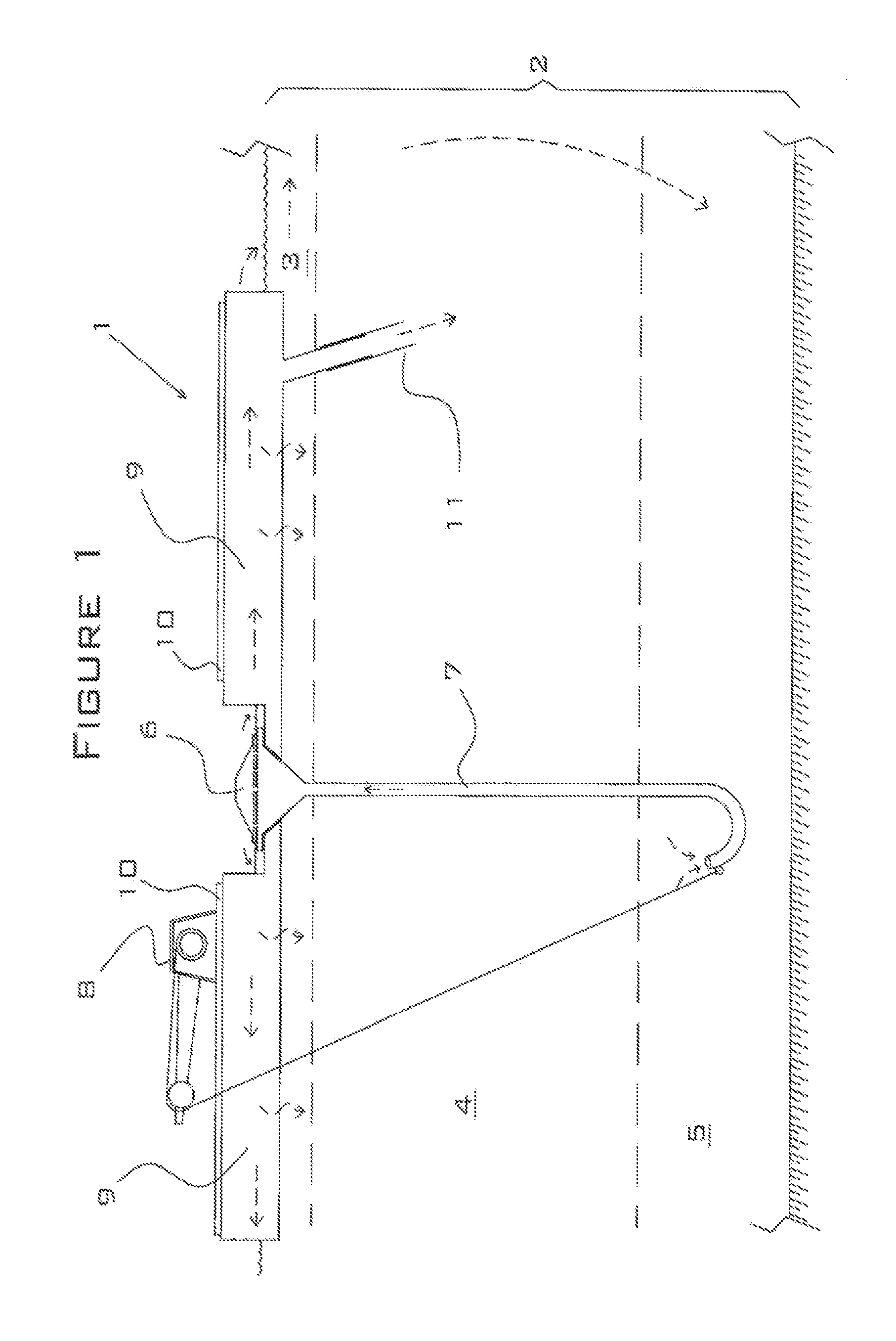Floating treatment streambed
a technology of floating treatment and streambed, which is applied in the field of water treatment, can solve the problems of limiting the species of fish, the majority of the water volume in these bodies cannot support fish life, and the inability to provide habitat for fish and other aquatic wildlife species,
- Summary
- Abstract
- Description
- Claims
- Application Information
AI Technical Summary
Benefits of technology
Problems solved by technology
Method used
Image
Examples
first embodiment
[0166]FIG. 3 is a schematic cross-section view of a treatment channel 9. In this embodiment, walkways 10 are positioned on either side of the treatment channel 9. This figure also shows the permeable matrix 14, the periphyton layer 15, the treatment water 13, and the flotation units 16. The treatment channel 9 is shown floating in stratified water body 2. The dashed arrows in FIG. 3 represent the portion of treatment water 13 that percolates through the periphyton layer 15 and the permeable matrix 14. Note that water may percolate downward through the bottom of the treatment channel and also horizontally through the sides of the treatment channel. The periphyton layer 15 grows naturally on the bottom and sides of each treatment channel under typical ambient pond conditions.
[0167]Periphyton is typically a mixture of algae, cyanobacteria, bacteria, and their residue and detritus. Because algae require sunlight to survive, the periphyton layer 15 will typically be restricted to the out...
second embodiment
[0175]FIG. 4 is a schematic cross-section view of a treatment channel 9, which incorporates an optional impermeable channel liner 18 and an optional top cover 19. With this embodiment, percolation of the treatment water 13 through the permeable matrix 14 is prevented. This embodiment is preferred for applications in which it is desirable to maximize the time that the treatment water remains within the channel for treatment or for applications in which the channel contains in-stream filters.
[0176]The impermeable channel liner 18 may be comprised of materials that are suitable for use as pond liners—for example, polyethylene, polyvinyl chloride, EDPM rubber, or polypropylene sheeting. The impermeable liner material is preferably resistant to degradation by ultraviolet sunlight and is resistant to punctures and tears. The top cover 19 may be comprised of gas-impermeable polymer sheeting to prevent the treatment water 13 from coming into contact with atmospheric oxygen (exclusion of oxy...
third embodiment
[0177]FIG. 5 is a schematic cross-section view of a treatment channel 9, which comprises aquatic plants 20 and riparian or terrestrial plants 21. (As shown in this figure, the plants may be located within the treatment channel itself or in the matrix 14 on either side of the treatment channel.) The plants may be used to increase the removal rate of excess nutrients from the treatment water 13 via phytoextraction. The plants 20, 21 may also contribute to the aesthetic appeal of the structure. Wetland sod 22 or bedding plants or plugs may be used to grow the aquatic plants 20. Wetland sod is typically comprised of aquatic and riparian plants that are rooted into coir or jute blankets. One supplier of wetland sod is Great Bear Restoration of Hamilton, Mont. If wetland sod is utilized, it may be attached to the treatment channel bottom. Grass sod, bedding plants and / or seeds may be used to grow the riparian or terrestrial plants 21. The bedding plants or plugs and seeds may optionally b...
PUM
| Property | Measurement | Unit |
|---|---|---|
| lengths | aaaaa | aaaaa |
| cured density | aaaaa | aaaaa |
| diameter | aaaaa | aaaaa |
Abstract
Description
Claims
Application Information
 Login to view more
Login to view more - R&D Engineer
- R&D Manager
- IP Professional
- Industry Leading Data Capabilities
- Powerful AI technology
- Patent DNA Extraction
Browse by: Latest US Patents, China's latest patents, Technical Efficacy Thesaurus, Application Domain, Technology Topic.
© 2024 PatSnap. All rights reserved.Legal|Privacy policy|Modern Slavery Act Transparency Statement|Sitemap



